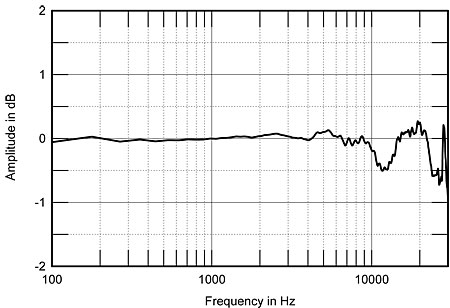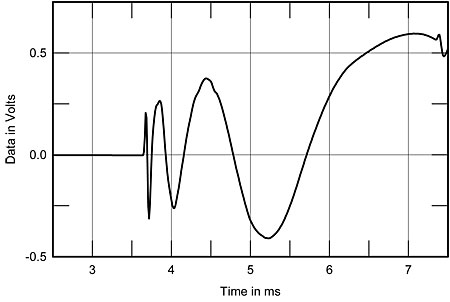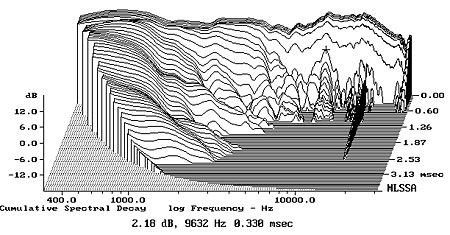| Columns Retired Columns & Blogs |
Dickie? Vivid? Is this a porn double entendre?
Other than the in-room and nearfield measurements, for which I used an Earthworks QTC-40 microphone, I measured the Vivid G1Giya with DRA Labs' MLSSA system and a calibrated DPA 4006 microphone. Wes Phillips mentions the fact that the domes of both 50mm upper-midrange units had been damaged late in his auditioning. This occurred after I had performed the in-room measurements but before I took any of the other readings. Vivid sent two replacements, but one of those arrived damaged, apparently at the hands of US customs. Stephen Mejias and I therefore replaced the unit in the G1 that was most seriously damaged—not a trivial task, but Vivid's instructions were comprehensive—and it was on that sample that I performed all the remaining measurements. I did take "before and after" measurements, however, to be sure that the replacement drive-unit had the same sensitivity as the original.
The G1Giya is a physically large, bulky speaker, so I had to perform all the measurements in situ at Wes Phillips' home rather than chez moi, where I would have used my backyard with its infinitely high ceiling. While it was possible to lift the speaker onto my Outline speaker turntable, the quasi-anechoic measurements will still be slightly affected by the presence of boundary reflections, particularly that of the woofers from the floor. I don't believe this had a significant effect on the absolute accuracy of the graphs, however.
I estimated the G1Giya's voltage sensitivity as 88dB(B)/2.83V/m, which is 3dB lower than the specified 91dB. The G1 is specified as having a 6 ohm nominal impedance, with a minimum value of 4 ohms. Fig.1 shows that the minimum impedance magnitude is a little lower than specified, at 3.27 ohms at 20Hz and 3.35 ohms at 60Hz, though the electrical phase angle tends to be large only when the impedance is also high, thus mitigating its effect. While there is a fairly demanding combination of 5 ohms and –42° at 15Hz, there will be no musical energy in this region to lead to drive problems. The impedance remains above 8 ohms throughout the midrange and above 12 ohms in the treble, which might make the G1Giya sound a little uptilted when driven by a tube amplifier having a typically high source impedance.

Fig.1 Vivid G1Giya, electrical impedance (solid) and phase (dashed). (2 ohms/vertical div.)
The small wrinkle in the traces at 34kHz indicates that this is the primary resonant frequency of the small-diameter tweeter dome. Another wrinkle, at 450Hz, might be due to a cabinet resonance of some kind. However, using a stethoscope and Faber Acoustical's SignalSuite generator running on my iPod Touch, I could only detect mild cabinet problems. (Logistical problems—I left it at home when I visited Wes—meant that I couldn't test the cabinet with my usual accelerometer.) The highest-level modes were on the sidewall level with the lower midrange unit at 275 and 315Hz, with another low-level mode audible at 550Hz. This behavior should not have any subjective consequences.
The green trace in fig.2 shows the response of the lower-midrange unit, measured in the nearfield. This driver appears to cross over to the twin woofers (blue trace) at 220Hz as specified, with symmetrical fourth-order acoustic slopes, also as specified. The woofers have some slight peakiness evident in the midrange, but this is well suppressed by the crossover and will be ameliorated by the fact that the woofers fire to the speaker's sides. The black and blue traces are identical below 100Hz because, contrary to my usual practice, I have shown the port response (red trace) separately rather than calculate the complex sum of the woofer and port responses. This was again due to logistical problems; the file containing the port output measured with MLSSA was corrupt and I had to remeasure it at a later date with a different, more portable system (Fuzzmeasure from SMUGSoftware). I also repeated the woofer and midrange nearfield responses, to check that there was no systematic error, which there wasn't.

Fig.2 Vivid G1Giya, anechoic response on upper-midrange axis at 50", without grilles, averaged across 30° horizontal window and corrected for microphone response, with complex sum of nearfield midrange and woofer responses plotted below 300Hz (black), and with nearfield responses of lower-midrange unit (green), woofers (blue), and ports (red), plotted below 400Hz, 1kHz, and 500Hz, respectively.
The woofers are loaded with a unique vented transmission line, which gives the G1Giya its distinctive shape. Conventional transmission-line designs almost always feature pipe resonances of some kind that give rise to problems in the upper bass. However, the outputs of the G1's woofers (fig.2, blue and black traces) are generally smooth within their passband; though some small peaks might be due to residual line effects, these are too small to have any effect on the quality of the low-frequency sound. Laurence Dickie's tapered lines do appear to work as advertised. The port's output (red trace) basically reinforces the G1's output below 30Hz and rolls out in a relatively well-behaved manner above 45Hz. (I usually plot nearfield responses by scaling them in the ratio of the square roots of the respective radiating areas, but the complex shape of the G1Giya's port opening meant that I had to guesstimate its relative level.)
Higher in frequency in fig.2, the G1Giya's farfield response, averaged across a 30° horizontal window on the upper-midrange axis, is smooth and even, though it does look as if there is a slight excess of energy in the midrange and a slight lack of energy in the mid-treble. The upper-octave response is well extended. Wes had a problem with the G1's wire-mesh grilles, writing that they "muffle[d] the sound to a degree that .†.†. affected their openness and detail more than I could tolerate." Fig.3 shows the effect of the grille on the Vivid's response measured on its upper-midrange axis. You can see that while the grille does have a slight effect, this is restricted to the speaker's output above 10kHz, and then suppresses the tweeter's output by, at most, only 0.5dB. I'm not sure, therefore, why the grilles would have as much of an effect on the sound as Wes found in his auditioning, though they did bong a bit when struck.

Fig.3 Vivid G1Giya, effect of grilles on anechoic response on upper-midrange axis at 50" (1dB/vertical div.).
A speaker's perceived sound balance depends on its dispersion as well as on its direct sound. Fig.4 shows the Vivid's lateral dispersion, referenced to the response on the upper-midrange axis. The radiation pattern is admirably smooth and even between 500Hz and 8kHz, something that always correlates with stable, accurate stereo imaging. Below that range is a slight dropoff at extreme angles, presumably due to the crossover between the lower-frequency drive-units, while above 8kHz, the speaker becomes a little more directional than I was expecting from its use of a small-diameter tweeter. In a large room, therefore, the G1s might sound a little mellow, though this will be offset if the owner uses a tube amplifier, due to the impedance effect mentioned earlier. In the vertical plane (fig.5), the Giya's response changes very little over quite a wide window—just as well, given that the upper-midrange axis is a high 43" from the floor.

Fig.4 Vivid G1Giya, lateral response family at 50", normalized to response on upper-midrange axis, from back to front: differences in response 90–5° off axis, reference response, differences in response 5–90° off axis.

Fig.5 Vivid G1Giya, vertical response family at 50", normalized to response on upper-midrange axis, from back to front: differences in response 15–5° above axis, reference response, differences in response 5–10° below axis.
The red trace in fig.6 shows the G1Giya's spatially averaged response, calculated from 20 measurements of the left and right speakers individually taken in a vertical rectangular grid 36" wide by 18" tall and centered on the position of WP's ears in his listening chair. As suggested by the direct-sound response in fig.2, there is a little too much energy in the midrange, but the balance above that region smoothly slopes down in textbook manner for this kind of measurement. (The room furnishings become increasingly absorptive with increasing frequency.) Lower-frequency room effects are relatively minor, although there is the usual midbass boost due to Wes's room acoustic. The low bass is excessive, due, I suspect, to the G1's port output coinciding with the frequency of the diagonal mode in WP's room. But even without that reinforcement, the G1 is a full-range design capable of delivering full output down to 20Hz. The blue trace in fig.6 shows the spatially averaged response of the Thiel CS3.7s in the same room. As WP commented, the Thiels have significantly less low-frequency output, and their relative excess of presence-region energy will reduce image depth compared with the Vivids, and contribute to his finding that the Thiels had a little less "timbral richness."

Fig.6 Vivid G1Giya, spatially averaged, 1/6-octave response in WP's listening room (red); spatially averaged response of Thiel CS3.7 (blue).
Turning to the time domain, fig.7 shows the G1's step response on its upper-midrange axis. All the drivers appear to be connected in positive acoustic polarity and the first reflection of the speaker's high frequencies, from the ceiling, can be seen just before the 7.5ms mark. The positive-going steps show, from left to right, the arrivals of the tweeter, upper-midrange unit, lower-midrange unit, and woofers; again in textbook manner, the decay of each drive-unit's step is smoothly integrated with the start of the step of the next lower in frequency. Although it isn't evident on the scale used for this graph, the port's output is, unusually, also in positive acoustic polarity.

Fig.7 Vivid G1Giya, step response on upper-midrange axis at 50" (5ms time window, 30kHz bandwidth).
Finally, the G1Giya's farfield cumulative spectral-decay plot (fig.8) is not quite as clean as I was expecting. There is a low-level mode evident at 9.6kHz, which I imagine is the upper-midrange unit's primary dome resonance after it has been suppressed by the crossover's steep low-pass filter, and there is a slight step evident at 3.9kHz.

Fig.8 Vivid G1Giya, cumulative spectral-decay plot on upper-midrange axis at 50" (0.15ms risetime).
Measuring a speaker as large and bulky as Vivid Audio's G1Giya always involves more uncertainty than it does with a minimonitor, just because of the difficulties in handling the speaker. But other than the slight excess of midrange energy, the G1's measured performance is superb, particularly that commendably smooth in-room response. The G1Giya is a worthy successor to Laurence Dickie's ground-breaking B&W Nautilus.—John Atkinson

Dickie? Vivid? Is this a porn double entendre?